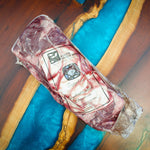
Chapter 5: Hereford
In the emerald-green pastures of England, where gentle breezes sway the grassy sea, the Hereford cattle graze—a breed that embodies the harmonious blend of docility and culinary excellence. The Hereford, with its distinctive red coat and white face, stands as an icon of well-marbled beef and a testament to centuries of careful breeding and husbandry.
Origins and Aesthetic Appeal:
The Hereford breed finds its roots in the picturesque county of Herefordshire in England, where it evolved through a combination of indigenous cattle and imports, including Dutch and Asian breeds. With their characteristic red coats, white faces, and a white crest along the neck, Herefords are not just practical grazers but also picturesque additions to pastoral landscapes.
The distinctive appearance of Herefords serves more than aesthetic purposes. The white face, in particular, provides a practical advantage in hot climates by reflecting sunlight, reducing heat stress in the cattle.
Docility and Temperament:
Hereford cattle are known for their gentle nature, making them favored choices for farmers and ranchers alike. Their docility simplifies handling, making them suitable for various management systems, from small family farms to extensive ranching operations.
The calm temperament of Herefords contributes to stress-free handling, fostering positive relationships between cattle and caretakers. This amicable nature is not only a boon for ease of management but also aligns with the overall well-being of the cattle.
Well-Marbled Beef and Culinary Excellence:
Hereford beef, renowned for its well-marbled texture and rich flavor, is a result of centuries of selective breeding. The marbling, the intricate distribution of fat within the muscle, is a key factor in Hereford beef's culinary appeal. It ensures tenderness, juiciness, and a depth of flavor that has made Hereford beef a favorite in kitchens around the world.
The breed's ability to convert forage efficiently into high-quality beef has contributed to its global popularity. Whether enjoyed as a succulent steak, a hearty roast, or in classic beef dishes, Hereford beef consistently delivers a premium dining experience.
Global Presence and Adaptability:
Herefords, born in the English countryside, have traveled the world and adapted to diverse environments. From the green hills of the United Kingdom to the vast plains of North and South America, Herefords have left their hoofprints on global agriculture.
The breed's adaptability to different climates and grazing conditions has made it a valuable asset to cattle producers seeking a versatile and hardy breed. Herefords have not only maintained their historical significance but have also evolved to meet the demands of modern beef production.
Hereford Genetics and Modern Agriculture:
The genetic influence of Herefords extends beyond beef production. Hereford genetics are frequently utilized in crossbreeding programs to enhance traits such as fertility, calving ease, and adaptability. The breed's genetic contributions play a role in improving overall herd performance and efficiency in various cattle operations.
Conclusion: The Legacy of the White-Faced Icons:
As Hereford cattle graze in pastures around the world, their legacy continues to grow. They are more than livestock; they are the gentle giants that bring harmony to the agricultural landscape. From the green meadows of England to the ranches of the Americas, Herefords represent not just a breed but a commitment to excellence in beef production—a legacy that spans centuries and continues to shape the tapestry of global agriculture.





